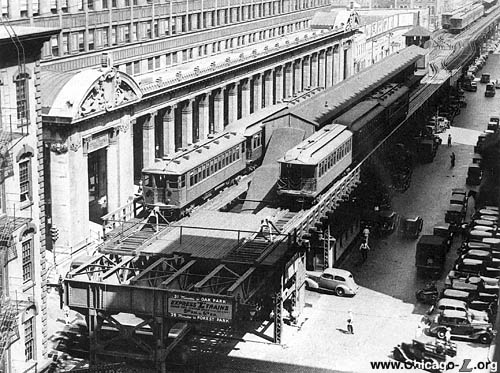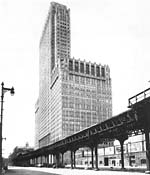
Market Street stub terminal
is seen here looking north in 1930. When it was built,
Market Street was industrial; by this point, it stood in
front of Chicago's new Civic Opera House. The station had a
single island platform between two pocket tracks with a
crossover at the north end of the station. Note the sign on
the end of the structure advertising express trains to Oak
Park and Forest Park. For a larger view, click
here.
(Photo from the Chicago Transit
Authority Collection)
|
Market Terminal
(1N-S/360W)
Madison Street and Market
Street, Loop
Service
Notes:

|
Lake Street
Line, Market Stub
|
Quick Facts:
Address: TBD
Established: November 6, 1893
Original Line: Lake Street Elevated Railroad
Other Names: Market/Madison, Market Stub Terminal
Skip-Stop Type: n/a
Rebuilt: n/a
Status: Demolished
History:

The Market Street stub is
under construction in this 1893 view looking north from
Madison Street. This is the eventual site of the Market
Terminal. The building on the left is the future home of the
Civic Opera House. For a larger view, click here.
(Photo from the CTA Collection)
|
Like the Congress Stub terminal of
the South Side Rapid Transit, the Lake Street Elevated initially
ended its run at a terminal outside downtown in the days before the
Loop Elevated. The company's initial franchise allowed construction
only as far east as Canal Street on the west
side of South Branch of the Chicago River. In early 1893, the Lake
Street Elevated received a charter to build a branch extension into
the outskirts of downtown to the corner of Madison Street and Market
Street. Although this was still blocks short of the heart of
downtown, it may have been chosen because Market was a wide boulevard
and the owners of its factories and warehouses were generally
receptive to the idea of transit access. The franchise was adopted
with little difficulty.
The station had a single island platform with a peaked canopy
between two stub tracks. A crossover and tower were located at the
north end of the station controlling access not only to the two
station pockets but to a center track that ran between Madison and
Randolph stations.
When the Lake Street "L" received permission to construct a
segment from Market Street to Wabash Avenue (which would eventually
become the north side of the Loop) in mid-1894, a clause in the
franchise required the Market Stub be demolished, but even after the
opening of the Loop in 1897 the city took no action to force its
removal. In 1895, all trains were routed to the Lake/Wabash leg and
shuttle service from Canal Street was
instituted to Market Terminal for overflow traffic. When the Loop
reached capacity, the traffic to the Market Terminal was greatly
increased. The city did try to force its removal with a 1914
ordinance, but it was generally ignored.
When the stub terminal opened in 1893, Market Street, like much of
the west Loop area, was light industry, warehouses, and modest
businesses. By the time of the Depression that atmosphere was
changing. A big part of that change was the construction of the Civic
Opera House on Market between Madison and Washington, looming over
the old Market Terminal. Built in 1929 and designed by the firm of
Graham, Anderson, Probst & White, the Opera House was financed by
traction magnate Samuel Insull, who was chairman of the Chicago Rapid
Transit Company, owner of the "L". The building is shaped like an
enormous armchair -- its 12-story "seat" is the opera house and its
45-story "back" is the office tower -- earning it the nickname
"Insull's throne." The "chair" faces west, supposedly turning its
back on New York City and the East Cost, which had spurned
Insull.
When the Chicago Transit Authority look over in 1947, the Lake
Street Division was only running overflow express trains to the
Market Stub, with Austin-to-Market Stub local-expresses (express
Hamlin to Oakley, then local to
Madison/Market) in the morning and Market Stub-to Forest Park
local-expresses (local to Oakley, express to Hamlin,
local to Forest Park) in the afternoon
and evening. The Lake Street Line was targeted as the first to have
its operations overhauled and on April 5, 1948 it was the first line
to receive the CTA's® new A/B
skip-stop scheme. This streamlined operation did not require the
Market Stub, which the city desired to get rid of anyway. The city
lost little time in demolishing the stub after service was withdrawn,
making way for the construction of the double deck Wacker Drive.


|
marketTerminal01.jpg
(152k)
By 1930, Market Street's industrial look had disappeared
as the Loop expanded. The Market Stub was now in the shadow
if the then-new Civic Opera House, completed the year
before. The Civic Opera Building was built by utility
magnate Samuel Insull, who was the chairman of the Chicago
Rapid Transit Company, the "L"'s private owner. The facade
facing the Chicago River is shaped like an enormous
armchair; its 12-story "seat" is the opera house and its
45-story "back" is the office tower. Critics at the time
referred to the building as "Insull's throne."
(Photo from the Chicago Transit Authority
Collection)
|





